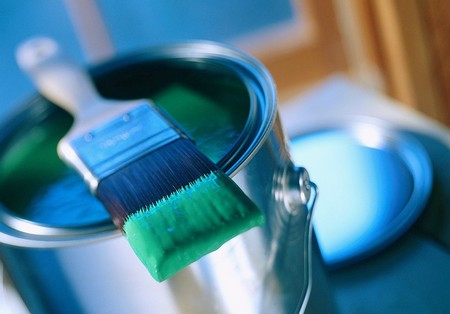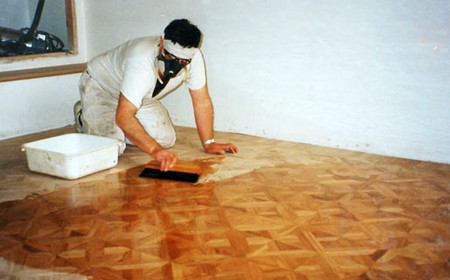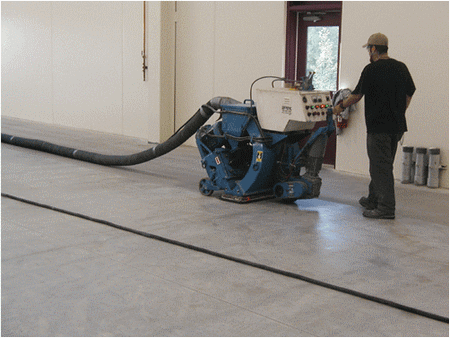Thorough surface preparation is the key to successful decorating and though it might seem a poorly rewarded chore, it should be approached with vigour and enthusiasm. Surface preparation means the patient and thorough removal of dirt, grease, corrosion and old decaying and unsound paint, and providing a finely abraded surface for maximum key. In the short term, thorough surface preparation will mean the disappearance of all surface blemishes, old paint chips, cracks and so on when you apply the final coat of paint. But the real reward will not be seen for a number of years – it is a long life for both the paint and the surface you are putting it on. How much this matters depends on whether you are decorating indoors or outdoors. Indoors you may well want to change your decoration scheme before it deteriorates, but outdoors you want to get the longest possible life out of your paintwork.
Preparing new surfaces
Many new surfaces need relatively little work before you paint them – some may need to be rubbed down with abrasive paper and others may need to have surface hollows smoothed out with a filler. The first coat of paint on most new surfaces is a primer this provides a key for subsequent coats of paint and should stick well to the surface you put it on, perhaps by sinking in slightly. You then follow the primer with whatever undercoats and topcoats you want.

Details of how to prepare different new surfaces are given below.
Softwood
This is light in colour, has an open grain and may have knots. It is the most common building wood used inside houses – for making stairs, door frames, skirting and so on. Softwood is often painted or clear varnished. For both, it needs sanding down (rubbing with an abrasive) to provide an even, but microscopically coarse, surface into which the sealing coat of primer or the first coat of varnish can key. The rougher the wood surface, the coarser the grade of abrasive you can use but always finish with a fine grade paper and always rub with the grain.
After rubbing it down, fill all cracks and holes before painting or applying a clear finish. For painting, common white filler is satisfactory but if you want to apply a clear finish, choose a coloured filler to match the natural colour of the wood – white fillers will look unsightly through the clear finish.
Never try to remove any stains on new wood by washing it with a cleaner containing water. Wood readily absorbs moisture and this makes the wood grain on the surface swell so you have to rub it down again. Use white spirit to remove stains or abrade them away. If you want to paint new indoor woodwork, make sure that it is left for a few days in the room where you want to use it with the heating on. This will remove any excess moisture in the wood which, if left, would expand, vaporise and cause the new paint to blister.
Before applying a primer, all knots and areas of resin – recognised by a darker brown stain in wood must be scaled with one or two thin coats of knotting.
Once the primer is dry, it will need gently rubbing smooth with a fine abrasive before the next coat is applied. Most primers give wood a fairly rough appearance by lifting tiny wood fibres into the paint surface. One coat of primer is sufficient for most new softwood surfaces. However, the end grain should always have a second coat – the first coat will probably sink in.
You may come across grain fillers in the shops. These should be used indoors and then only when you want a superfine finish. Normally, they are a white or beige paste which you rub into the surface of the wood using a circular motion and then lightly abrade the surface smooth once the filler is hard. You can use a fine-textured sanding-grade filler as an alternative.
If you want to give softwood a clear finish, you can stain it to a darker shade or to another colour either by rubbing a wood slain into the wood surface before varnishing or by using a tinted varnish. The former method generally produces the best results and is more permanent -the colour of the stain remains even if the varnish film is subsequently removed. If you no longer want this colour you can try to remove it using a bleaching agent, but good results cannot be guaranteed.
External wall cladding and fencing which have been left with a rough sawn finish need little or no surface preparation. This sort of woodwork is often supplied impregnated with a wood preservative. Use a brush to remove all surface dirt before applying an additional coat of wood preservative.
Hardwood
This is generally darker in colour than softwood and has a closer, more even grain – oak, mahogany and teak are typical examples. Paints and varnishes deteriorate fairly rapidly on hardwoods outside and it is always worth thinking about using a preservative wood slain rather than paint. Wood prcscrvalivcs require little or no preparation for re-coating and often enhance the natural beauty of the wood.

For paint (or varnish), rub down the wood surface before priming. With some oily woods, such as teak, the surface oil should be removed by wiping the wood with a rag soaked in white spirit. Some other hardwoods – mainly the more unusual ones – keep exuding an oily resin to which conventional primers will not stick well. Aluminium primer may solve the problem check by priming a small area of the wood surface and then attempting to scratch it off two days later. If the primer does not stick, a preservative wood stain is a better choice.
Hardwoods can be stained in the same manner described for softwood. Beech looks particularly effective when stained with bright colours and can be used for making brightly coloured toys.
Chipboard
If the chipboard is clean, all you need to do is to smooth off any cut edges and lightly abrade the surface of the board before priming. Pre-sealed boards do not need priming. All primers are likely to cause some surface unevenness equivalent to raising the grain on natural wood. Water-based (acrylic) primers are particularly troublesome. With these, you should not smooth the surface until you have applied the undercoat, otherwise abrading will simply remove all the primer from the high spots leaving them liable to swell again when you apply the next coat of paint.
Hardboard
If the surface of the board is clean, lightly abrade it and then apply a primer
Softboards As long as the surface is clean no further preparation is required.
Because softboards are so absorbent, they are often painted with an emulsion or other water-based paint. A stabilising primer may be needed.
MDF
MDF’s smooth surface takes paint or varnish with no preparation.
Metal
Ferrous metals (those containing iron) quickly become coated with a reddish-brown film of rust unless they are painted or coated with a rust-resistant metal. New galvanised surfaces many window frames and garage doors, for instance – are coated with a corrosion-resistant non-ferrous metallic film of zinc. These, and other similar metal-coated surfaces, should be treated as if they were non-ferrous.
If a ferrous metal surface shows no signs of corrosion, it will need a little preparation before priming. But such a situation is very unusual, so you should look carefully to sec whether it has an oil or grease coating. If so degrease it by using a degreasing agent, such as white spirit, or a paint brush cleaner. Wash this off with water; dry the surface as quickly as possible (by wiping down and then using a fan heater or hairdrier) and then prime it at once. New ferrous metal surfaces which show no sign of rusting may have been coated with a clear lacquer – if so, lightly abrade the surface and prime.

Asbestos
Never rub down asbestos sheets – asbestos dust can damage your health. When trying to get rid of asbestos, your safest bet is to hire a commercial asbestos contractor and have them properly dispose of the health hazard. According to commercial asbestos removal services, you have no way of knowing whether asbestos is present without testing because the fibers are microscopic, which can only be carried out by an EPA-certified contractor. If asbestos is identified, the demolition and removal must also be carried out by a certified asbestos abatement contractor.
Plaster
Sound dry walls do not need any special preparation. If the walls are still drying out, use emulsion or other water-based paints only. If the walls have efflorescence – a surface deposit of salt crystals which originate deep in the wall (or plaster) and are transported to the surface by moisture escaping from the new plaster and brickwork – brush it off at regular intervals until the formation of crystals stops. Do not try to remove efflorescence with water you will soak the salts back into the plaster and they will reappear to damage and discolour paintwork at some later date. Do not paint the plaster until efflorescence stops.
Plasterboard
This is normally supplied with a different surface on each side. The grey side is for plastering and the ivory side is for painting. As long as the surface is clean and dry, no further preparation is required.